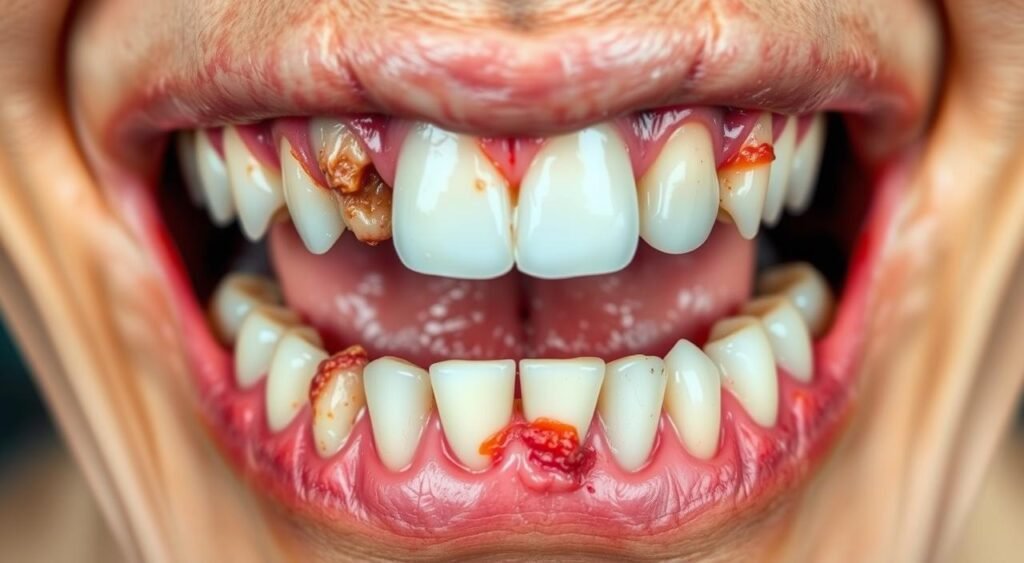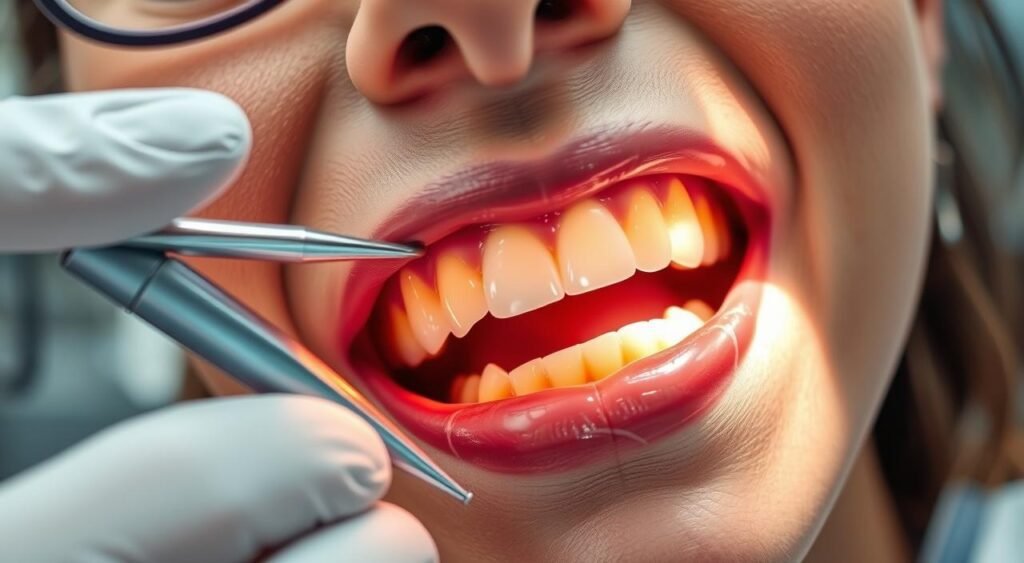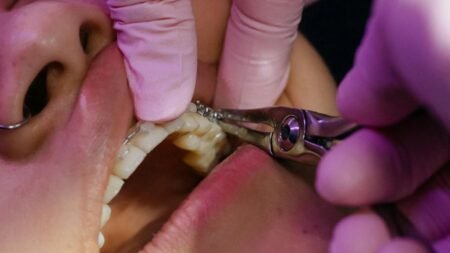Periodontal (gum) disease is a serious issue that can cause you to lose many teeth if ignored. But, how long can you keep your teeth with this chronic infection? The answer might surprise you and could help you keep your smile.
Gum disease starts with bacterial infections in the gums and gets worse over time. The first stage, gingivitis, can often be fixed with good oral hygiene. But, if it moves to periodontitis, it destroys the bone and tissue that hold your teeth in place. At this point, losing teeth is likely if you don’t get treatment.
So, how long can you keep your teeth with periodontal disease? It depends on how bad your condition is, your health, and the treatments you get. With careful dental care and early treatment, you can manage periodontal disease and keep your natural teeth for many years. But, it’s crucial not to let it get to the advanced stages.
Understanding Periodontal Disease
Periodontal disease, also known as gum disease, is a chronic condition. It affects the gums and the teeth’s supporting structures. It begins with gingivitis, a stage where certain bacteria cause gum inflammation.
Symptoms of gingivitis include bleeding gums, tender gums, and redness. If not treated, gingivitis can turn into periodontitis.
What Is Periodontal Disease?
Periodontitis is a more severe stage. Bacteria grow in the space between the gums and teeth, called the periodontal pocket. This leads to tissue damage and creates a place for more bacteria to grow.
Causes of Gum Disease
- Poor oral hygiene, like not brushing and flossing enough, lets plaque build up and harden into tartar.
- An imbalance in the oral microbiome, or oral dysbiosis, lets harmful bacteria like Porphyromonas gingivalis, Tannerella forsythia, and Treponema denticola grow.
- Some risk factors, such as smoking, diabetes, and genetics, make people more likely to get gum disease.
Knowing about periodontal disease’s causes and how it progresses is key to keeping your mouth healthy and preventing tooth loss.
Progression of Periodontal Disease
Gingivitis: The Early Stage
Gingivitis is the first stage of periodontal disease. It can cause bad breath, red and swollen gums, tooth sensitivity, and more. If not treated, it can get worse.
Not brushing and flossing regularly lets plaque turn into tartar in just 48 hours. Tartar can’t be removed with brushing and flossing. It moves under the gum line, causing the gums to recede and the infection to spread to the bone.
Periodontitis: The Advanced Stage
Periodontitis is the most severe stage of periodontal disease. It happens when gingivitis is ignored and the infection grows. This stage can lead to tooth loss and other health issues.
Periodontitis damages the gums, connective tissues, and bones that hold the teeth. It makes chewing painful and can cause bleeding gums and more.
| Stage of Periodontal Disease | Symptoms | Potential Consequences |
|---|---|---|
| Gingivitis | Persistent bad breathRed and swollen gumsTooth sensitivityPainful chewingReceding gums | Can progress to periodontitis if left untreatedPlaque hardens into tartar, which cannot be removed by brushing and flossingTartar expansion beneath the gum line causes gum recessionInfection can move to the underlying bone, causing further damage |
| Periodontitis | Tooth lossPainful chewingBleeding gumsFurther gum recessionOther health problems | Breakdown of gums, connective tissues, and supporting bones of the teethCan lead to serious health consequences if left untreated |
How Long Can You Keep Your Teeth with Periodontal Disease?
Many think that with periodontal disease, losing all your teeth is a sure thing. But, studies show that with the right treatment and care, many people can keep their teeth for a long time.
A 1978 study looked at 600 people with gum disease. Half of them didn’t lose a single tooth over 22 years. The other half lost teeth, but not all of them. Only 25 out of 600 lost 10 to 23 teeth.
Another study in 2003 followed 156 patients with gum disease for 12 years. By the end, only 61 patients had lost a tooth or had one taken out. This shows that most patients could keep their teeth with good gum disease management.

These studies show that catching gum disease early and taking good care of your teeth can help. Many people with periodontal disease can keep their teeth and reduce tooth loss. The prognosis for people with periodontal disease is better than many think, if they get the right care and listen to their dentist.
Risk Factors for Tooth Loss
Periodontal disease is a chronic condition that affects the gums and teeth. It’s a big reason for tooth loss. But, losing teeth isn’t just about gum disease. Some risk factors can make losing teeth more likely, even without gum disease.
Age
Getting older raises the risk of losing teeth. About a third of people over 65 have lost 6 or more teeth. This happens due to gum disease, tooth decay, and other health issues that affect dental health as we age.
Smoking and Alcohol Consumption
Smoking and drinking too much alcohol are big risks for losing teeth. Smokers are 20 times more likely to get periodontal disease than non-smokers. This greatly raises their risk of losing teeth. Drinking a lot of alcohol also raises the risk of gum disease and losing teeth.
Chronic Conditions
Some health conditions make losing teeth more likely. People with diabetes, osteoporosis, or Alzheimer’s are more at risk. These conditions can affect dental health and increase the chance of losing teeth. Managing these conditions well is key to keeping teeth healthy and preventing tooth loss.
| Risk Factor | Increase in Tooth Loss Risk |
|---|---|
| Age (65+ years) | 1 in 3 individuals have lost 6+ teeth |
| Smoking | Up to 20 times more likely to develop periodontal disease |
| Alcohol Consumption | Elevated risk of gum disease and tooth loss |
| Diabetes | Increased risk of periodontal disease and tooth loss |
| Osteoporosis | Weakened bone structure can lead to tooth loss |
| Cognitive Disorders (e.g., Alzheimer’s) | Impaired ability to maintain proper oral hygiene |
Non-Surgical Periodontal Treatments
For those with mild gum disease, like gingivitis or mild periodontitis, non-surgical treatments work well. These methods focus on removing tartar and bacteria under the gum line. This helps the gums heal and stick back to the teeth.
Scaling and root planing is a key non-surgical treatment. It uses special tools to clean plaque, tartar, and bacteria from teeth surfaces. The roots are smoothed, making it easier for gums to reattach.
Patients may need several visits for complete cleaning. It takes about four weeks for the gums to heal fully. Regular check-ups help keep the mouth healthy by removing plaque and checking for more treatment needs.
For severe gum disease, treatments might combine with other therapies. Using sub-antimicrobial doxycycline can help reduce inflammation and aid healing.
Early treatment can prevent surgery and help keep natural teeth longer. But, regular dental visits and good home care are key for long-term success against gum disease.
Surgical Treatments for Advanced Periodontitis
When non-surgical treatments don’t work, surgery might be needed for advanced periodontal disease. These surgeries help fix the damage and stop it from getting worse. They aim to make your mouth healthy again.
Pocket Reduction (Osseous Surgery)
Pocket reduction, or osseous surgery, is a common surgery for advanced periodontitis. It removes tartar and bacteria from around the tooth roots. This makes the pockets smaller.
The tooth roots get cleaned, and the bone is reshaped. This helps create a better environment for gum health.
Soft Tissue Grafts
Soft tissue grafts are another surgery option for treating advanced periodontitis. They help fix receding gums. This is done by taking a thin tissue from the roof of the mouth and placing it between the gums and tooth.
This allows the new tissue to grow into healthy gums. These surgeries, along with good oral hygiene and regular dental care, can help you keep your natural teeth longer. They also lower the risk of losing teeth due to this condition.
Regenerative Treatments for Advanced Periodontitis
Advanced periodontal disease can be treated with regenerative treatments. These treatments help restore damaged jaw areas. Guided bone regeneration is a key method to rebuild lost bone due to gum disease.
Guided Bone Regeneration
Guided bone regeneration is a complex process. It uses a special membrane to help bone grow back around teeth. First, the affected areas are cleaned and prepared. Then, a tissue-guiding membrane is placed between the gum and bone.

This membrane keeps the bone and gum tissue from being affected by other tissues. The regeneration process takes about six months. During this time, the bone and gum tissue grow and get stronger.
This can save teeth at risk of falling out. Or, it can prepare the area for dental implants if saving the original teeth is not possible.
Guided bone regeneration is crucial in fighting advanced periodontitis. It helps restore lost bone and supports the health of teeth and gums. This treatment can keep patients smiling naturally for many years.
Conclusion
Periodontal disease is a long-term condition that needs ongoing care to stop tooth loss. About half of people with this disease won’t lose any teeth. But, risk factors like age, smoking, and certain health conditions can make losing teeth more likely.
Early treatment, like scaling and root planing, can slow down the disease. For severe cases, surgery might be needed to fix damaged tissues and rebuild bone and gum. Keeping up with good oral hygiene, including brushing, flossing, and dental check-ups, is key to keeping your teeth, even with periodontal disease.
With the right care and treatment, many people can manage periodontal disease and keep their natural teeth. By tackling the root causes, using effective treatments, and being proactive with oral health, you can lessen the effects of this condition. This way, you can keep a healthy, beautiful smile for life.
FAQ – Periodontal Disease
How long can you keep your teeth with periodontal disease?
About a third of people over 65 have lost 6 or more teeth, but not all lost teeth are from gum disease. A 1978 study found that half of 600 people with gum disease kept all their teeth. Another 199 lost 1-3 teeth, 76 lost 4-9 teeth, and 25 lost 10-23 teeth. A 2003 study observed tooth loss over 12 years in 156 patients, and only 61 had lost teeth during that time, showing similar trends.
How long does it take for gum disease to develop?
Gingivitis, the first stage of gum disease, causes bad breath, red gums, and sensitivity. It’s not destructive initially but can worsen without proper care. Plaque hardens into tartar within 48 hours, which cannot be removed by brushing and flossing, requiring professional cleanings to manage.
Can you die from gum disease?
Periodontal disease isn’t directly deadly, but it can lead to serious health issues. Bacteria from gum disease can spread, increasing the risks of heart disease and stroke. Proper treatment and hygiene can significantly reduce these risks.
Will I lose my teeth if I have periodontal disease?
Not everyone with periodontal disease loses teeth. About half of those affected keep all their teeth. Risk factors like age and smoking can increase the likelihood of tooth loss. Early treatments like scaling can control the disease, while advanced cases may require more intensive treatments.
How long does it take for periodontal disease to heal?
Healing time depends on the severity of the disease and the treatment. Non-surgical treatments can take weeks or months for full healing. Surgical treatments may take longer but can restore gum and bone health effectively.
What is the connection between periodontal disease and tooth loss?
Periodontal disease is a leading cause of tooth loss. Without treatment, it damages the jaw bone that supports teeth. Bacteria in periodontal pockets cause tissue destruction and deepening pockets, leading to tooth loss if untreated.
What is periodontal disease?
Periodontal disease results from bacterial infections in the gums. Good oral hygiene can prevent it from progressing. Neglected gum disease starts with gingivitis, causing bad breath, red gums, and sensitivity. If untreated, it advances to periodontitis, leading to tooth loss and other health complications.








